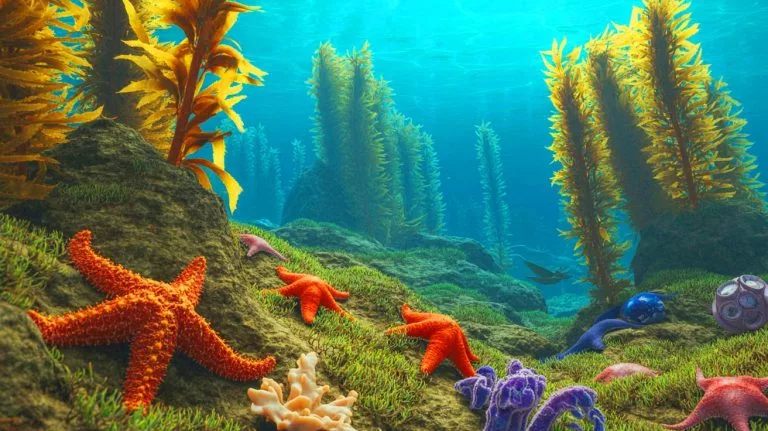| IN A NUTSHELL |
|
The mysterious disappearance of billions of sea stars along North America’s Pacific coast has perplexed scientists for over a decade. Recently, researchers have identified a single bacterial species as the root cause of this devastating marine epidemic. The bacterium, Vibrio pectenicida, has unleashed a rapid and deadly disease among sea stars, causing them to develop lesions, lose their arms, and eventually disintegrate. This revelation marks a significant step forward in understanding the crisis and opens new avenues for potential solutions. However, the broader ecological impacts of this epidemic highlight the urgent need for effective intervention and conservation strategies.
Unraveling the Mystery of Sea Star Wasting Disease
For years, the cause of the sea star wasting disease remained shrouded in mystery. Initial investigations pointed to a densovirus, commonly found in healthy sea stars, as the potential culprit. However, this theory proved to be a dead end. The turning point came when researchers shifted their focus to the coelomic fluid, the internal “blood” of sea stars, instead of analyzing only the dead tissue. This approach led to the identification of Vibrio pectenicida, a bacterium that eluded detection due to its inability to persist in deceased specimens.
The breakthrough discovery was confirmed through experimental infections. Healthy sea stars exposed to Vibrio pectenicida exhibited rapid tissue loss and ultimately succumbed to the disease, mirroring the symptoms observed in the wild. This newfound understanding provides scientists with a tangible target to combat the epidemic.
“There have been lots of competing theories over what causes sea star wasting disease, so it’s great that we know what is actually causing it,” said marine invertebrate curator Dr. Hugh Carter.
https://www.sustainability-times.com/research/shocking-eggs-emerge-underwater-volcano-unleashes-swarm-of-massive-living-pods-that-leave-terrified-scientists-scrambling-for-answers/
The Ecological Impact of Losing a Keystone Species
Sea stars, particularly the sunflower sea star (Pycnopodia helianthoides), are keystone predators in the Pacific’s intertidal ecosystems. Their decline has triggered a cascade of ecological consequences, reminiscent of other historical environmental tipping points. The absence of these predators has allowed purple sea urchins to proliferate unchecked, leading to the decimation of kelp forests.
Kelp forests, often referred to as the “rainforests of the sea,” are vital for marine biodiversity. They serve as nurseries for fish, feeding grounds for marine mammals, and play a crucial role in stabilizing shorelines by buffering against storms. The loss of these forests has far-reaching implications, threatening fisheries, seabird colonies, and the overall balance of the nearshore ocean.
This scenario mirrors past ecological disruptions, such as the eradication of wolves from Yellowstone National Park in the early 20th century. The removal of wolves led to an overpopulation of elk, which in turn degraded vegetation and riparian habitats. Similarly, the removal of sea stars from the Pacific coast is reshaping entire shorelines and altering the ecosystem’s natural rhythm.
The Role of Vibrio Bacteria in Marine Ecosystems
Vibrio bacteria, including Vibrio pectenicida, are not foreign invaders to marine ecosystems. They are integral components of the ocean’s ecological fabric, involved in nutrient cycling, organic matter decomposition, and sustaining marine health. However, under certain conditions such as warmer waters, nutrient surges, or host stress, these bacteria can shift from benign to opportunistic, causing widespread devastation.
The challenge in addressing the sea star epidemic lies in the dual nature of Vibrio bacteria. They are both essential and potentially harmful, depending on the environmental context. This duality complicates efforts to mitigate the impact of the disease, as interventions must be carefully balanced to preserve the beneficial roles of Vibrio bacteria while preventing their lethal outbreaks.
Understanding these dynamics is crucial for developing effective conservation strategies that can restore and maintain the health of the Pacific’s marine ecosystems.
Path Forward: Conservation and Restoration Efforts
With the identification of Vibrio pectenicida as the culprit behind sea star wasting disease, scientists can now focus on developing strategies to restore affected populations. Captive breeding programs, such as those at the Seattle Aquarium, are working to raise healthy sunflower sea stars for eventual reintroduction into the wild. These efforts represent a critical step toward rebalancing the intertidal ecosystems.
However, restoring balance to the Pacific coast’s living infrastructure is a complex and long-term undertaking. It requires collaboration between scientists, conservationists, and policymakers to effectively address the ecological impacts and implement sustainable solutions.
The road ahead is challenging, but the newfound understanding of the disease provides a glimmer of hope for the future of the Pacific’s marine ecosystems.
The identification of Vibrio pectenicida as the cause of sea star wasting disease marks a significant milestone in marine science. As researchers and conservationists work to combat this epidemic, the broader question remains: How can we prevent such ecological crises in the future and ensure the resilience of our oceanic ecosystems?
Did you like it? 4.5/5 (27)







Wow, fascinating read! Are there any efforts to stop Vibrio pectenicida from spreading further? 🦠
Wow, this is like a marine detective story! 🕵️♂️
Vibrio sounds like a villain from a superhero movie. 😄
Was climate change a factor in the rise of this bacteria?
How can the public help with the restoration efforts?
Can Vibrio pectenicida affect other marine species too?
This is why we need more funding for marine research! 🐟
Are there any other solutions apart from captive breeding programs?
It’s alarming how one species can have such a massive impact on the ecosystem.
Why are sea urchins so problematic without sea stars?
Is there any hope for the affected kelp forests to regrow naturally?
Thank you for bringing awareness to this critical issue. 🙏
Could this bacteria cause similar problems in other parts of the world?
The sea star apocalypse sounds like a sci-fi novel title!
What measures are being taken to prevent future outbreaks?
This is heartbreaking! I hope the sea stars can make a comeback. 🌟
How do scientists plan to monitor the recovery of sea star populations?
It’s incredible how interconnected everything in nature is.
Anyone else think Vibrio would make a great name for a punk band? 🎸
How did they finally figure out it was Vibrio pectenicida?
How long until we see a significant recovery of sea star populations?
Did sea stars have any natural predators before all this happened?
What a relief to finally have some answers after all these years.
Are similar bacterial outbreaks happening with other marine species?
Can the bacteria be eradicated or just managed? 🤔
Thanks for the informative article. I learned a lot! 📚
Is there a possibility that Vibrio pectenicida could mutate?
So, Vibrio bacteria are like the frienemies of the ocean? 🤔
It’s heartbreaking to see such a key species disappearing. 😢
Why did it take so long to identify Vibrio pectenicida as the cause?
Can sea stars be bred in captivity and then released back into the wild successfully?
What a tragedy for the marine ecosystem. We need more conservation efforts ASAP!
I’m glad they finally found the culprit, but why did it take so long?
Are there any signs that kelp forests can recover if sea stars are reintroduced?
Great job to the scientists for solving this mystery! 🕵️♂️
This is a great example of how interconnected ecosystems are. We need to act fast!
The comparison to Yellowstone’s wolves is spot on. Nature’s balance is so fragile.
Is this bacteria harmful to humans as well?